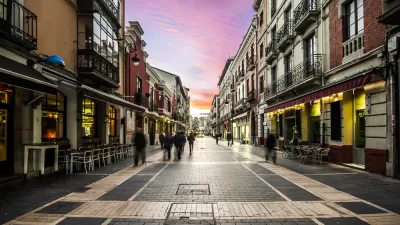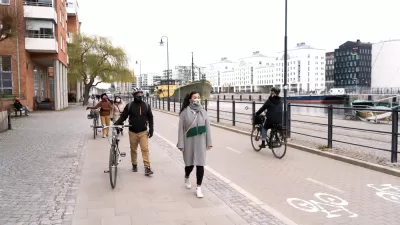Rather than trying to meet all of a community's needs within a one-minute radius, Sweden's Street Moves pilot program gives residents the power to decide how street space gets used.

Move over, "15-minute city," writes Feargus O'Sullivan for Bloomberg. Sweden is pioneering the "one-minute city," a hyper-local vision inspired by the push for decentralizing urban services and creating dense, walkable communities where residents can find almost everything they need within minutes.
Locally-focused schemes such as the 15-minute city and Barcelona's famous superblocks gained steam in 2020 as shelter-in-place orders made people hyper-aware of their immediate neighborhoods and emphasized the need for locally available services and local infrastructure that improves quality of life. Sweden's approach focuses even more closely on "the space outside your front door — and that of your neighbors adjacent and opposite," according to Dan Hill, director of strategic design for Vinnova, Sweden's national innovation agency.
The project, dubbed Street Moves, is being piloted in four sites around Stockholm, where residents can decide how street space is used and allocated through community workshops and consultations. The goal isn't to make everything available within one minute, but rather to reimagine the patches of street immediately outside the home as "critical connecting spaces for communities" and not just "places to move and store cars." If successful, Sweden plans to implement the program on every street in the country by 2030.
FULL STORY: Make Way for the ‘One-Minute City’

Manufactured Crisis: Losing the Nation’s Largest Source of Unsubsidized Affordable Housing
Manufactured housing communities have long been an affordable housing option for millions of people living in the U.S., but that affordability is disappearing rapidly. How did we get here?

Americans May Be Stuck — But Why?
Americans are moving a lot less than they once did, and that is a problem. While Yoni Applebaum, in his highly-publicized article Stuck, gets the reasons badly wrong, it's still important to ask: why are we moving so much less than before?

Using Old Oil and Gas Wells for Green Energy Storage
Penn State researchers have found that repurposing abandoned oil and gas wells for geothermal-assisted compressed-air energy storage can boost efficiency, reduce environmental risks, and support clean energy and job transitions.

Updating LA’s Tree Rules Could Bring More Shade to Underserved Neighborhoods
A new USC study finds that relaxing Los Angeles’ outdated tree planting guidelines could significantly expand urban tree canopy and reduce shade disparities in lower-income neighborhoods, though infrastructure investments are also needed.

California's Canal Solar Projects Aim to Conserve Resources and Expand Clean Energy
California’s Project Nexus has begun generating electricity from solar panels installed over irrigation canals, with researchers and state agencies exploring statewide expansion to conserve water and boost clean energy production.

HHS Staff Cuts Gut Energy Assistance Program
The full staff of a federal program that distributes heating and cooling assistance for low-income families was laid off, jeopardizing the program’s operations.
Urban Design for Planners 1: Software Tools
This six-course series explores essential urban design concepts using open source software and equips planners with the tools they need to participate fully in the urban design process.
Planning for Universal Design
Learn the tools for implementing Universal Design in planning regulations.
Heyer Gruel & Associates PA
City of Moreno Valley
Institute for Housing and Urban Development Studies (IHS)
City of Grandview
Harvard GSD Executive Education
Salt Lake City
NYU Wagner Graduate School of Public Service
City of Cambridge, Maryland





























